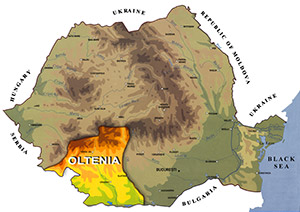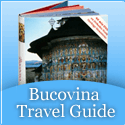Oltenia – Traditions
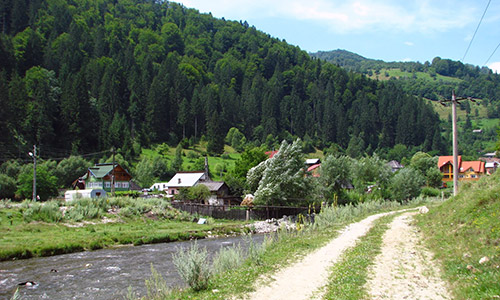
Traditional House | Traditional Costumes | Occupations and Crafts | Food | Birth | Marriage | Death
For people in Oltenia, tradition has meant something sacred, with Christian principles, with well-outlined customs and traditions that have been respected and protected.
The people from Oltenia, just like all the Rumanian people, think in a Latin manner and together with the Greek people, they form two of the oldest Christian nations from the South-Eastern Europe. People from Oltenia are proud, kind, social, they love their land and don’t hesitate to present it to the visitors. In the historical archives, the Getic populations lived north from the Danube and were mentioned for the first time by Herodot in the 4th century B.C. The Getic men were recognized for their brave during battles and perhaps this explains why the Getas were the only population that still remained in this ethnographical area, despite the wars, the many years of Roman colonization and the attacks of the migratory peoples. It is true that their influences can be traced in the vocabulary, customs, traditions and the dishes of the Romans.
The intelligence of the people from Oltenia is famous. It is said that most of them are born to be leaders. This innate ability to lead other people makes them leave their native land, because there’s no point in leading, as long as everyone is “a leader”. This feature makes them be easily recognized, not only because of their leek smell they have. If one shouts on the streets “hey, chief!”, there are 99% chances that the one who pays attention to this call comes from Oltenia.
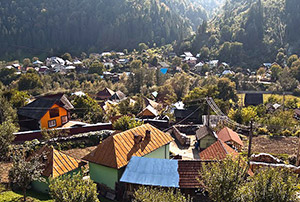
The people from Oltenia are very superstitious and today there is the belief in bad spirits (moroii). When there’s drought, people still dance the “paparude” (ancient ritual dance for summoning the rain and prosperity).
The people from Oltenia speak very fast and they use the “perfect simple” tense (a past tense), feature that is like a label for them. They can be easily recognized because of this feature and some historians say that the people from Oltenia and the British might have common roots. But there were found no proof that could state this.
Having a real talent for leadership, they try to manifest themselves like that everywhere they can. One of the former presidents of Romania (Nicolae Ceausescu), former govern leaders (Radu Vasile, Mugur Isarescu), they all come from Oltenia. Because the people from Oltenia are very proud, they changed the name from Craiova to Craiova Prazburg, which is a German word for “leek” (leek=praz, Prazburg means in fact the leek town).
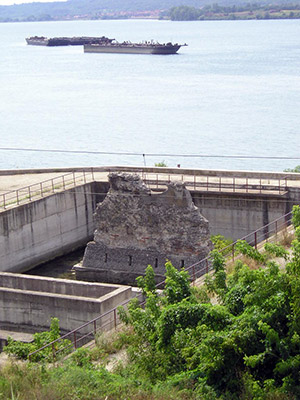
There are many places that prove the influence of the Roman Empire, such as: The bridge on the Danube, built by Apollodor from Damascus as an order from the emperor Traian (this happened after the first Dacian-Roman war). The bridge is described by the Roman historian, Cassius Dio :” It is wonderful, just like the other edifices built by Traian, but this one impresses through its tremendous size”, There are 24 stone columns that are 150 feet tall, without including the base in this calculation, and 60 feet thick. These are grouped in pairs and displayed at a distance of 170 feet one from another and are connected by an arch.
The ruins of the bridge crossing the Danube may be seen even today on Romanian and Serbian territory. The Roman camp “Drobeta” lies on the Northern bank of the Danube. Near the camp, one may see the Roman thermae installation, the biggest building of this kind from the Roman Dacia.
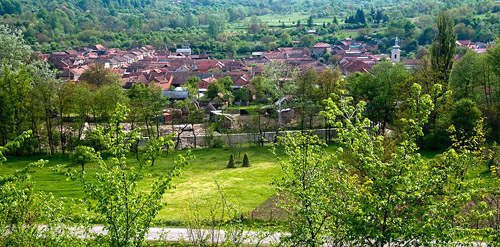
Traditional House in Oltenia

The rustic household specific to this area has individualised itself along the time, taking into account the historical and social-economical conditions. There are many exemples of rustic houses built with artistic skill, beeing in fact true monuments of wood architecure and masonry. The most amazing rustic architecture has developed in the district of Gorj. The oak tree is the main building materials. The tall socle, the arcade-like columns are made of stone and brick. The roof made of sheet and the tile instead of the shingle are more and more present.
The blueprints of the house starts with the entrance hall, in the middle, and then two, three or four rooms are displayed one after another. The same display is applied to the rooms separated from the porch. The porch extends on two or three sides. The houses in Gorj impress and draw the attention through their size (low or high) and through their decorative work. The low house is massive, without being heavy, and the high house can be characterised as having a slim form, because of the pillars.
The decorative work of the house keeps the tradition of wood carving. The wooden frame of the windows with carved rosettes is a new decorative element. About the diversification of carving and chiseling works that adorn the houses from Gorj one may say that it is endless, a main role is played by the entrance gates of the yard. They draw the attention through the greatness of their architecture, through their vigor and the richness of their decoration.
The wood represents, too, in Valcea district, the main building materials together with the building face stone, materials that are used not only as low base for the houses with one floor, but also as developed socle, that shelters the cellar of the high houses. From the old decorative systems, the new house has taken only the main structure, which is changed a little into a new form. Also, the plaster is sometimes coloured and the ornamental figures are grouped at the cornices and around the windows, just after the model of the town-like houses.

In Mehedinti, the interior of the houses is different in the Northern side of the district from the interior of the houses from the Southern side of the same district. In the North, the blueprint of the old houses is characterized by the presence of the partial porch and of supra-dimensional room, meaning that the entrance hall and a room with one entrance are included. The ceiling of the rooms is made of visible girders and deal boards. The walls are made of clay and are afterwards lime washed. The floor is made of clay. At the more recent houses, the blueprint of the houses has developed, because another room was added on the other side of the entrance hall.
This blueprint includes an entrance hall and two living rooms, and in the front there is a porch that lies on the whole longitudinal side of the house. In the central and Southern part, the interior consists of three chambers: the living room, the entrance hall and the clean room. The ceilings have as support the reed (trestie) on which the plaster stands and the floor is made of boards, especially in the dinning room.

An old element preserved in Mehedinti is the free bakestone with suspended chimney, being a very important place in the house. The positioning of the bakestone varies according to each part of the area. The form can also be different according to each part of the area. The shape may vary from square to rectangular and it’s built of bricks or stone. As a specific element for Mehedinti, we can mention the embedding of one or more earthen pots in the walls of the oven. These earthen pots are used for baking but also for enlarging the space that irradiates heat.
As for furniture, there are beds and benches that are stuck in the ground, benches that are fixed in the wall by a board and also a dowry chest.
We may see the “culme”, which is a wooden rod placed above the bed or near the oven. This rod is used for drying the clothes and has also decorative purposes, because it may be used as a support for exposing the celebration clothes in the guest’s room. The entrance hall, or “foc”, how it is called in the South of the country, where the bakestone is situated, serves as kitchen, diurnal room, place for having dinner, pantry, and in the past, this is the place where the brood hen used to stay with the baby chickens. Among the interior decorative items, one may remark the dowry chests and the troughs for maize. The chests draw the attention immediately, as their decorative work presents combinations of straight and black lines mixed with red and black figures.
The walls are covered with textures that expose a fantastic coloring. In celebration days, the beds are covered with red, white, green and black woolen carpets. On the walls near the bed, people hang carpets on which two or three cotton or raw silk towels are nailed.
The traditional costumes from Oltenia

The traditional costume from Oltenia is one of the most complex fields of popular art because of the variety of the pieces it consists of, of the techniques and materials used, of the organization of the decorative works and most of all, because of the motifs used.
Oltenia, an ethnographical area with an artistic and expressive individuality, presents a great diversity of costumes. The traditional costume is different from one area to another. The traditional costumes from Romanati-Olt area are special through their particular features, enriching the field of popular decorations with original motifs full of special plastic value.
The women’s costumes are included into the typology of the popular costume with the “valnic” from Oltenia and consists of the raw silk apron, the chemise with hems, “valnic” or “zavelci”, the homespun skirt (specific only to Romanian peasants), the girdle, rods, footwear. The women’s costume is one of the most decorative in Oltenia. Only married women cover their heads with a raw silk head kerchief which is adorned with necklaces. On the wedding day, women wear a red fez, and sometimes they put a black silk tassel on top of their heads, tassel which is fixed with long pins. The raw silk head kerchief is worn over the red fez and its ends are usually let to drop on the women’s back or it is covered around their necks, with one end falling on their backs and the other one hanging in front. The chemise belongs to the general category in women’s costumes, being wavy at the collar and it’s sewn with cherry silk and sometimes with dark blue silk, at the point where the bar borders the opening of the chemise, the end of the sleeves and of the hem. “Valnic” consists of two wavy rectangular aprons that are pleated at the waist by introducing three or four woolen strings, which are worn in the back, covering the hips. The shape of the “valnic” is similar to the shape of a fan, being flaring at the hem. As far as the decorations are concerned, one may see the rhombus, the wheel, “gura papusii” (the mouth of a doll), “zaluta” (a necklace-shaped flower sewing). The “valnic” is worn folded on the hips with its open side in the front. Over this open side, women wear also a shorter linen apron (pestelca). The upper side of the “valnic” is covered with the waistbands that wrap up the waist.

The homespun skirt is decorated horizontally with lineal motifs and with stylizations of the elements of nature. Especially in spring and autumn, the women wear “casaca”, which is a long dark coat without any sleeves, but they wear also a long fur coat, that has long sleeves with black or dark blue ornaments, presenting a sober decoration formed of straight or easily twisted strings displayed on the hem, on the sleeves and around the collar.
The footwear consists of long woolen socks (long up to the knee) that are either red or black and peasant sandals (opinci).
The men’s costumes consist of a straw hat which is realized in their own household or by some other craftsmen (the skull cap has a special shape and the brim is 7-8 wide) and of a shirt that has a low collar and also buttons. The shirt is long, it can reach the knees and it’s made of two linen pieces. The trousers of the summer costume are made of cotton linen in two shafts with little circles. There are two kinds of belts: one that is 40 cm wide and 2-3 cm long sewn in two shafts in small squares and stripes (which are displayed vertically) and another one that is 7 cm wide and 2-3 m long (worn only for the summer celebration days). The “casaca” completes somehow the costume (in a way it’s similar to the women’s casaca, the only thing that differentiates them is the colors of the decorations).

“Valcea”, as an ethnographic zone, imposes certain rules that point out the material and civil status of the one that wears the costumes. Just like in Romanati, the girls wear nothing on their heads, their hair is tied in queues and when they get married they cover their heads in the celebration days with the head kerchief and in the working days with the mousse line. The women’s costume is unique through the coloring of the homespun skirt, of the “valnic” and the blue and vivid red shirts. The “valnic” is worn with a homespun skirt that is very much decorated in the front. The old women’s costumes present a sober chromatic, with less adornments. Besides the raw silk head kerchief, the old women wear also some black shawls, especially in winter. The adornments are used mostly by girls and young women. These adornments are in fact colored pearls displayed usually on black velvet ribbon worn around one’s necks.
What the men’s costumes are concerned, the chromatic variety is more restricted, the young men wear mostly the manly shirt, having its hem and collars decorated. They also wear a” skirt” over their trousers (called “cioareci”). The old men wear a shirt which is tied over the belt with a money pouch.
A special attention is given to the embroidered peasant shirt that is characterized through a diverse chromatic with floral motifs and the richness of pearls. Almost all these embroidered shirts are adorned with pearls of every color, making them weigh up to 3 kg. In the essential moments of their life, the elders want to have traditional clothes by their side so that when they die, they can be buried wearing the rustic costumes or even the traditional costume that they wore when they got married.
The holiday called: “The round dance of the costumes” plays a very important role in keeping the tradition of the rustic costumes alive. This event is organized annually in the Palm Sunday.
In the district of Mehedinti, the women’s traditional costume presents two main models that can be included in the general typology of the historical province of Oltenia, and namely : the two homespun skirts costume which is predominant in the North and the “valnic” costume which can be seen in the South. The two homespun skirts costume (called also “opreg ingust” and “fastac”) presents a linear decoration, namely there are some horizontal back stripes and vertical front stripes. What makes this costume unique is the diverse direction of the stripes that alternate without interruptions, revealing modest motifs chosen after the crossbeam. The red background is also specific to these pieces of clothing. People’s heads are adorned with a towel after the hair has already been tied in a loop. The second type of costume with “valnic”, locally called “opreg cret” is the celebration costume. Its different appearance from the costume with two homespun skirts can be spotted first of all in the flaring line of the silhouette. The “valnic” is wavy in the waist, large at the hem and it covers the woman’s waist. Together with the luxurious-like clothes, the woman’s working outfit has been developed, called ”opreg invargat”, which is a modest type of clothing, associated with the usual shirt.
The man’s costume, just like in the other areas, is simpler to approach than the women’s costumes. The man can tie his waist with the belt and over the belt he may place a waistband. The trousers (cioareci) are worn till they reach the knees and in this way the shirt can be seen between the waistband of the trousers and the belt.

The foot wearing consists of peasant’s sandals (opinci) made of dressed pig or cow skin, sandals at whose pointed ends have toes (gurgui). There are also the so called :caltuni din dimie”(rough homespun woolen socks), which are worn by the women in winter. Over the socks, women usually wear a white foot wrap that is hemmed with red wool. The sandals are tied to the foot with some straps made of cow skin (“nojite”. The straps are folded three times and fixed with some iron brooches.
The traditional costume from Gorj district can be characterized by sobriety and elegance, through an attire that expresses the pride of the people from Gorj. The costume consists of a homespun skirt, called “fastac” and another one, called “catrintoi”. We may add the “valnic”, the shirt with hems (“ciupag”), the cotton apron, the waistcoat and the long fur coat for winter. What makes the costume from Gorj unique are the chromatic harmony, the vivid colors (blue, red and white), the diverse decorative work of the “valnic” costumes, work that consists mostly of geometrical figures, such as: rhombuses, crosses, spirals. An important moment in the evolution of the costume from Gorj is the “schilaresc” type of costumes, that appeared near 1900, style that adds new items to the traditional costume, especially items connected to the enrichment of the adornment and of the materials that were used to manufacture the costumes.
Occupations and Crafts

The development of this style is strongly connected to the rich flourishing of the popular art in the 19th century, as an effect of a structural benefic transformation, what the economic and social condition of the peasants is concerned.
In the hierarchy of the values of popular art, the carpets and the “chilims” (a kind of broidery made of woolen or silk threads). As a form of weaving, the carpet belongs to an old tradition, being the main decorative piece from the dowry of the peasants’ girls. The girls who possessed and realized carpets gained social prestige. The transportation of the dowry to the house of the son-in-law was in fact a ceremonial, where every piece had to be presented to the community. The carpet from Oltenia is essential, because of the vegetal motif. Usually, the frame of the carpet from Oltenia is covered by bouquets and branches with leaves and flowers (daisies and tulips) which are disposed horizontally in dense lines. The ornamental composition is developed through the use of some figural motifs (animals and people) that are integrated into the vegetal composition. The anthropomorphic motifs-women represented in motion, usually in a round dance (hora), or other characters-they appear as the constituents of a small real life scene. The coloring of the carpets is nuanced and subtle. The fields, usually appear colored in dark blue, cheery-coloured, azure, green, brown and they are unique through their fantastic shining. Into the decorative work of the carpets, we can also see birds, animals and various characters.
The field where the women-weavers from Oltenia have shown talent and creative imagination is that of the “chilims”. Unlike the other weaving materials, the “chilim” can be characterized by certain particularities in what the dimensions, the decorative work are concerned. The rectangular shape is well proportioned, with a vegetal and zoomorphic decorative work, presenting some of the borrowed motifs mixed with the traditional ones. It is manufactured from a wide sheet, and worked in the “chilim” technique, which allows the realization of some well-outlined motifs.
The rug from Oltenia is considered one of the most valuable types of Romanian carpet. We can find symbols and motifs that come from the inventory of the rustic and Brancovenian art, motifs whose significations are connected to the basic meaning of the Romanian spirituality, such as the rules of life, the horse and the horse-rider, the rooster, the cuckoo, the stag. The coloring is offered by the following colors: ultramarine, the pastel green, the cheery red, colors that make up the background and determine the chromatic of the ornaments.

The people are skillful not only at weaving, but also at pottery. The perfection of the technique of burning the pots and the introduction of the potter’s wheel have represented important events in the evolution of this skill.
The ceramic works from Oltenia bear in time the unique mark of the archaic cultures and civilizations from this geographic area. The manufacturing of ceramics is made manually, following a technological process that has been transmitted from generation to generation for hundreds of years. The main phases of the technological process are the following: the preparing of the clay for moulding (it must be fermented, cut, tempered, cleansed of impurities and then one should form the so called”gogoloaie” (small malleable spherical item depending on the size and shape of the pot), the moulding of the clay for obtaining the desired shape, then the shape must be dried, scraped, pierced and adorned; afterwards the figure must be burnt, enameled and then burnt again. These are all the steps for obtaining the final shape.
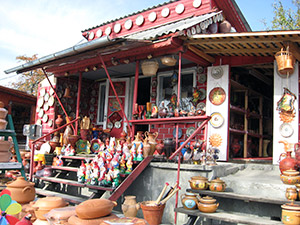
What emphasizes the potters’ contact to the old or new items made of ceramics is their creative assimilation of some shapes, kinds of pots from the main pottery centers from Sisesti, Targu-Jiu, Oboga, Horezu, Slatinoara.
The Hurezu pottery center was established when the Hurezu Monastery was founded by Constantin Brancoveanu. This was done for the new ruler of that time and for the boyar courts situated in the area. The ceramic items realized here gained positive remarks, especially because of the technical and decorative innovations of the era, namely the enamel and the development of the decorative and chromatic elements. The items are decorated with the chancel and with a kind of a brush made of the hair of a pig. The figures are diverse: the snail, the star, “altita” (stream of ornaments on a peasant shirt or blouse), the sterilized flowers, the rooster and the fish. Nowadays, there is an association of ceramic craftsmen, called “Cucosul de Hurez” and in the first Saturday and Sunday of the year the town of Horezu organizes the greatest fair of ceramics from the country where skilful craftsmen from all the country participate.

The ceramic center from Slatioara is specific for the traditional red ceramics that is not enameled, but is discolored with the white fire-proof clay (huma). The old tradition is kept also through the processing of the ceramics in the centers from Sisesti and Targu Jiu. For discoloring the pots, people use ancient motifs (the winding line, the triangle, the fir tree) and natural colors achieved from yellow and red clay. The ceramic items are for external use: pitchers, vessels that have various sizes used for preparing the food, barrels for extracting the butter.
Another famous center is the one from Oboga, which is unique through its sculptural character of the shapes and through the fact that on the specific items the name of the craftsman, the name of its origin place and the name of the decorative motif are carved. Among the items, one may remark the vinegar cruets with alveolate girdles, barrels, zoomorphic and anthropomorphic pitchers decorated in the form of small snakes and tiny frogs.
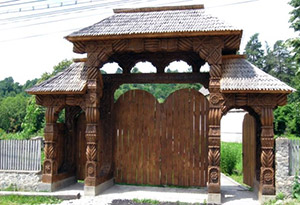
Woodworking represents one of these fields of work where the artistic virtues of the traditional craftsmen from Oltenia have been accomplished, revealing at the same time important achievements of the Romanian popular art. Categories of wooden items that take artistic shapes can be encountered in almost every field connected to rustic activities: elements of architecture, furniture, tools, house-hold usage items.
The techniques used in processing and decorating the wood are the following ones: the incision, the notching and the carving. The architectural elements that traditional sculpture points out are the pillars of the porch and of the balcony, the doors of the houses, the needles that conceal the girders at the corners of the buildings, the decorative ledges of the windows.
Among the wooden items, we can mention “the church door”, carved at the beginning of the 19th century and whose decorative work reveals a synthesis of traditional adornments (the sun, the snake, the phases of life) and cult adornments, specific to the Brancovenian art (the two-headed eagle, vegetal motifs).
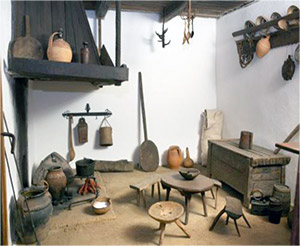
Another category of items is represented by the furniture consisting of dowry chests, tall wardrobes, tables with drawers, round tables. Visiting the villages from the district of Gorge, the doors and the windows remind us of the great sculptor, Constantin Brancusi. They present various floral and geometrical motifs.

Another ancient custom is apiculture, because the honey and the wax were used for illumination the homes and they were also used as food for the inhabitants.
Agriculture is another occupation of the peasant from Oltenia. The fieldwork can be accomplished even today with the help of the horse plough and the agricultural inventory consists of the bramble harrow, sickles, scythes, grit stone and prong hoes, wooden and iron pitchforks. An important feature of these tools is their adornment with various geometrical motifs .The crops are deposited in wattle baskets that are enlarged inside. Another tool that raises curiosity is the stony grinder on wooden pedestal and the soil test used at preparing cereals. “Rasnita”-a kind of mill-it’s a new invention and differs from the traditional mill, because of the notched wheels that generates the motion of the two stones and of the wooden chimney.
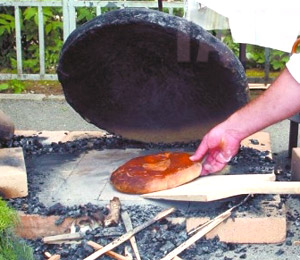
Food
The people from Oltenia are famous for their delicious dishes. A feature of this way of cooking is the preparing the food in earthen pots.
The peasants put an emphasis on cooking vegetables, such as: the stinging nettle, the garden sorrel, the green onion. The leek is an emblematical dish in Oltenia. It is a vegetable, similar to the onion, but it is hotter than the onion or the garlic. Its leaves are similar to the ones of the garlic and they can be cooked in diverse dishes or they can be consumed in their raw form, cut in circles (mostly used in salads). The leek must be added into he dishes after they have been cooked, so that they don’t lose their aroma. The soups are preferred sourer. The people from Oltenia make them sour with cabbage and tomato juice. They prefer chicken soups, vegetables, leek and pig weed. Usually, they spice their dishes with horse radish and chili pepper and as greenstuff, they use the parsley and the lovage. Among the special dishes from Oltenia, there are: the leek soup, leek with olives, traditional pottage, chicken cooked in white sauce with maize porridge (mamaliga), traditional sausages.
When it’s Christmas or Easter, the people from Oltenia have all their tables full of dishes. At Christmas, they don’t forget to cook the steak in fat. They eat it with fresh leek, jellied meat, thick sausage, forcemeat rolls of cabbage leaves (saramalute) and for Easter the women cook the traditional “pasca” (sweet cream cheese cake) and they paint the eggs in red. Together with these delicious dishes, people from Oltenia make a toast, they usually drink red wine, plum brandy or the so called ”palinca” (traditional drink).
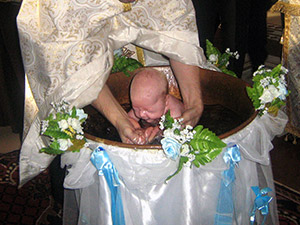
Birth
The holy christening is the sacrament through which man receives forgiveness from God for the ancient sin, he is born again with God’s grace and becomes a member of Christ’s Church. The christening is performed once only by the priest, but not before the 8th day and not after the 40th day of the baby’s life. In order to receive the Holy Sacrament of Christening, the child’s parents have to find a godfather. In Oltenia, the custom of the midwife, connected to the christening of the baby, is very strong. She brings the child to the church and says the following words: “the child’s a Pagan, but he/she will become a Christian” and when she returns from the church, she says: “the child was a Pagan and now he/she’s a Christian.” When the godparents take the child from the midwife, they offer her money, in order to repay her. The midwife is the one that takes the water in which the child was bathed and pours it near the root of an apple tree or pear tree, so that the child can grow healthier just like the specific tree.
Still in Oltenia, there is another custom called “datul de grinda” (hitting the girder). After the baby has been christened three times in the New Years’ Eve’s morning (once in the first three years), the mother goes with a present and with the child to the midwife, so that the child can be “dat la grinda”. The midwife puts the money into a “colac” or a pretzel and then she holds the child and puts the pretzel on his/her head and on top she puts a glass of wine. Afterwards she lifts him/her up three times and says each time: “long live my nephew/niece, may that he/she will be rich and full of luck and wisdom”. The midwife and the child have to stand towards east. Then the midwife sits on a table and is served with all kinds of traditional dishes.
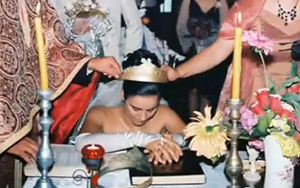
Marriage
Wedding is one of the most important moments of man’s life and it is considered a complex ritual that celebrates the joy of marriage. In order for two young persons to get married, they need godfathers or spiritual parents. In Oltenia, it is compulsory that the godfathers be one of the bridegroom’s christening godfathers, because if it’s done otherwise, the bridegroom might be cursed by them. The godfather and the godmother must buy presents for the bride and bridegroom, such as the bridegroom’s flower, the bride’s veil and the candles. In order for a girl to get married, it is necessary that she should name her dowry chest as “Lada de Brasov”. Within the box, there are things belonging to the bride and a bottle of wine, two glasses, two earthen plates for the bridegroom. The transport of the chest from the bride’s house to the bridegroom’s house is provided by the young men from the certain village.
The wedding call is done in the week when the wedding takes place, especially on Thursday and Saturday. Young people use to carry a hip flask of plum brandy or wine when they do the wedding call and who drinks, he/she must come to the certain wedding.
The wedding is controlled by the village chief. He deals with the invitations, the arranging of the tables, the rehearsals of the round dances (hore). His duty is also to organize people so that they participate to the marriage ceremony. He is the one that recites the epithalamiums (oratie) and gathers the bride and the bridegroom in front of their parents and tells them to ask their parents for permission. The father of the bridegroom must pay for everything on the wedding. The wedding fir tree-symbol of dignity and youth-is adorned in the last Saturday before the actual wedding. It is adorned by the bridegroom and bride’s friends. The bride receives two adorned fir trees and the same is with the bridegroom and godparents. The fir tree must be adorned with paper garlands, a set of bells, a kerchief, red and tricolor ribbons and on top of the fir tree one places a bottle of plum brandy or a pound cake. While the wedding, the fir tree is placed beside the gate. A girl and a boy have to stand near the fir tree and they have the duty to splash water and to throw wheat seeds on the wedding guests. The fir tree remains at the specific gate and is removed only when it slithers.
The bride is dressed by the godmother and her friends. The bridegroom comes to pick up the bride (he has to pay in order to step into the bride’s house and to look for the bride, because she hides somewhere in the house) and then they go to the church. The bride and her father-in-law hold each other’s hands and walk round a table on which a glass of wine and a table napkin are placed. Under the napkin, money is placed. While they surround the table, they have to touch the feet of the table and in the end they have to spill the glass of wine and take the money. The bride, helped by her brother-in-law, goes to three wells and when they reach the third well, they fill three buckets with water which they finally spill on the ground. Afterwards they dance a round dance (hora). Before going to the church, the godmother tears a “colac” (kind of fancy bread”) above the bride’s head and after the wedding, the bride and bridegroom eat the same “colac”. The big wedding feast can take place either in the bride or in the bridegroom’s house. The custom was in such a manner that the bride and bridegroom shouldn’t eat at the same table with the wedding guests, they used to eat from a bowl with a single wooden spoon and used to drink wine from the same bottle. This is done in order to them to learn how to share. They used to sit on knapsacks, so that they were tied up to them. They used to eat everything that was served (bread dipped in wine or they used to share an egg).
The menu didn’t use to be diverse, people served chicken soup, cooked cabbage, meat jellies, pickles, steak, donuts and plum brandy.
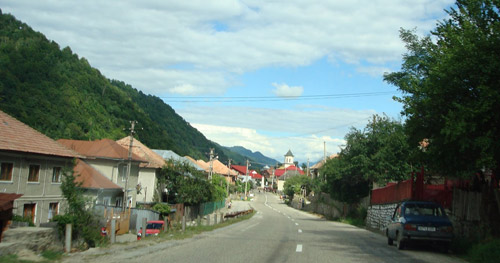
Another important moment of the ritual is “the uncovering of the bride”, meaning that the godmother invites the bride to sit on a pillow, so that she can take her veil off and to tie a kerchief over her head. The bride doesn’t want that and takes the kerchief off three times in a row. A young girl takes the veil and wears it on her head, so that she can have luck and to marry the same year. The actual bride comes in front of her bridegroom and of the wedding guests and then she dances the so called”Hora dezgovelei”, dance that signifies that the bride enters the world of the married women. Every wedding guest has to participate at this ritual dance, to dance with the bride, to kiss her and give her money. The bride spends the money the way her heart pleases.
The wedding gift used to be brought at the end, before the steak was put on the table. A fiddler or the village chief used to announce this moment. The first that used to offer money was the godfather, followed by the parents-in-law who had the duty to promise them the house, money, crops, animals. Everyone could give everything they could afford, from money to crops, animals, rugs, pillows, sheets.
After the wedding, the godfather used to go with a cask of brandy tied up with red ribbons to the parents of the bride, being accompanied by the bride’s brother-in-law and fiddlers. If the bride was a virgin till her wedding, the brandy used to be sweetened with sugar and colored so that it became red. If the bride wasn’t a virgin, than one put ash and chili peppers into the brandy, so that the bridegroom’s mother could laugh at the bride’s mother. People then used to celebrate the bride’s chastity and if she wasn’t a virgin, the girl’s father had to offer the sun-in-law some money or land, so that he could accept his wife.
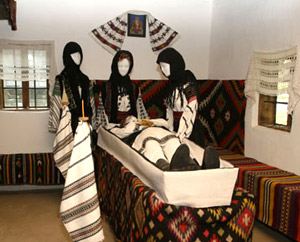
Death
The customs that concern the death of a man affirm that when the soul of dead person departs from the body, the mirrors from that person’s house must be covered with towels, because there is the superstition that his/her soul might reflect in it, which would bring only harm to the ones living in that house. In the coffin, under the head of the dead person, certain items are placed, items that are useful to him/her in the long journey. These things are: nine tiny stones, nine fragments of porcelain, nine thistle seeds, nine incense grains, the soap that was used for washing the dead person, the comb that was used for combing him/her (the comb must be split into three pieces) and a rope that was used for measuring the dead person’s height and also a flat cake.
A mythical custom is to offer the others the salt through the dead person’s hand. The salt symbolizes the prosperity of the house. It is hidden under the threshold, so that it cannot be stolen and after the dead person is taken to the cemetery, the salt is shared to the poultry of the household.
In order to keep away the bad spirits, the dead person is stung in the heart with a needle. This rite is done only after the dead person has stayed in the house for three days and only after the sun has set. Two women and a girl go to the cemetery and without uttering a word, they powder wheat grains from the vessel where candles have been lit while the dead person’s stay in the house. On the grave they put three garlic seeds, near the dead person’s head, waist and feet and three spindles and if all of these haven’t been put in the coffin, than they are thrust into the ground in such a manner than no one should see this. The grave is incensed three times.

The dish that is cooked afterwards is made of wheat. The wheat is washed in nine waters and then it is boiled till it becomes a homogeneous paste. The paste is mixed with sugar, nuts and flavors. The “colaci” (a kind of fancy bread) are round-shaped and in the middle one can see the dough in form of a cross. The tree of the dead person is made of a branch with three twigs of a fruit tree. Every twig is loaded with fruits and at the bottom of the tree people tie a handkerchief. After the burial, the priest sanctifies the gifts.
Another custom for the dead is the one from Joia Mare (the great Thursday) from the week of Christ’s Passions. The peasants wake up at 4 in the morning and commemorate their beloved dead relatives. They light the fire in from of their houses and then they go to the cemetery. Every old woman holds some corn cobs in their hands and then they light them in the front of the tombs of the dead ones. They also hold a bouquet of tulips and incense in their hands. The living ones start praying for the dead ones to return on this world to see how the life of their families goes on. On the way back from the cemetery, the women make “colaci” and pound cakes which they offer as charity afterwards.


 Travel Romania
Travel Romania Bucovina Traditions
Bucovina Traditions Maramures Traditions
Maramures Traditions Rustic Traditional Houses
Rustic Traditional Houses Tismana Monastery
Tismana Monastery Horezu Monastery
Horezu Monastery Women’s Cave
Women’s Cave Brancusi – Targu-Jiu
Brancusi – Targu-Jiu